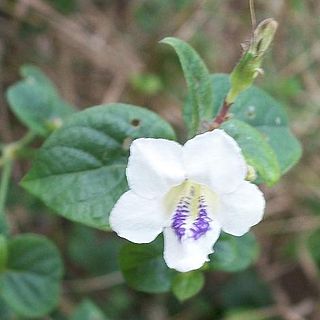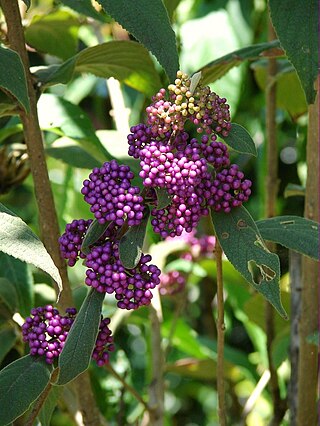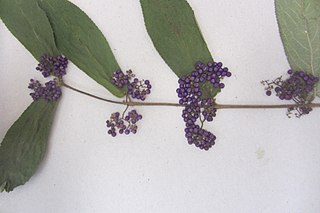
Asystasia gangetica is a species of plant in the family Acanthaceae. It is commonly known as the Chinese violet, coromandel or creeping foxglove. In South Africa this plant may simply be called asystasia.
Callicarpa maingayi is a species of beautyberry plant in the family Lamiaceae. It is found in Malaysia and Singapore.

Mikania micrantha is a tropical plant in the family Asteraceae; known as bitter vine, climbing hemp vine, or American rope. It is also sometimes called mile-a-minute vine.

Callicarpa americana, commonly called the American beautyberry, is an open-habitat, native shrub of the Southern United States which is often grown as an ornamental in gardens and yards. American beautyberries produce large clusters of purple berries, which birds and deer eat, thus distributing the seeds.

Callicarpa bodinieri, or Bodinier's beautyberry, is a species of flowering plant in the genus Callicarpa of the family Lamiaceae, native to West and Central China. Growing to 3 m (10 ft) tall by 2.5 m (8 ft) wide, it is an upright deciduous shrub with dark green leaves turning red in autumn (fall). In midsummer, small lilac flowers are produced in the leaf axils. But it is grown in gardens primarily for its small, decorative purple berries in tight clusters in autumn.

Callicarpa cathayana is a species of beautyberry. It is grown in gardens and parks as an ornamental plant for its decorative pink flowers and berries. The purple berries are a drupe. They are not edible for humans. Birds eat the berries and disperse the seeds. The species are endangered in the wild. Callicarpa cathayana is native to China.
Callicarpa longifolia is a species of beautyberry. It ranges from the Himalayas, east to Japan and south to Queensland. It is grown in yards and gardens as an ornamental plant. The roots are used as an herbal medicine to treat diarrheas.

Callicarpa mollis is a species of beautyberry that is cultivated and grown in gardens and parks as ornamental plant. It has purple flowers. It is found in Korea and Japan.

Callicarpa pedunculata is a shrub or small tree in the Lamiaceae family native to both Queensland and New South Wales.

Callicarpa rubella is a species of beautyberry native to Southeast Asia. It is a shrub that produces pink or purple flowers followed by dark-purple berries. The berries are actually drupes. It is grown in gardens as an ornamental plant. The fruit attracts wildlife such as birds.

Bridelia micrantha, the mitzeeri or the coastal golden-leaf, is a tree in the family Phyllanthaceae and is native to tropical and southern Africa as well as to the island of Réunion in the Indian Ocean.

Grevillea micrantha, also known as small-flower grevillea, is a species of flowering plant in the family Proteaceae and is endemic to Victoria in Australia. It is a spreading shrub with linear leaves and clusters of white to pale pink flowers.

Bidens micrantha is a species of flowering plant in the aster family known by the common name grassland beggarticks. It is endemic to the Hawaiian Islands, where it and other Bidens species are known as kōʻokoʻolau. It occurs in many types of habitat on Lānaʻi, Maui, and Hawaiʻi, including rocky cliffs, dry forests, mesic forests, wet forests, and high shrublands.
The micrantha is a wild citrus from the papeda group, native to southern Philippines, particularly islands of Cebu and Bohol. Two varieties are recognized: small-flowered papeda, locally known as biasong, and small-fruited papeda or samuyao.

Trema micranthum, the Jamaican nettletree or capulin, is a plant species native to warmer parts of the Western Hemisphere. It has been reported from Mexico, Central America, tropical South America, the Virgin Islands, Jamaica, Cuba, Hispaniola, Puerto Rico, and southern Florida.

Callicarpa (beautyberry) is a genus of shrubs and small trees in the family Lamiaceae. They are native to east and southeast Asia, Australia, Madagascar, southeast North America and South America.
Callicarpa lanata is a scientific name which may refer to two different plants
Callicarpa candicans is a species of flowering plant in the mint family. It is native Indochina, southern China, Malesia, New Guinea, northern Australia, and Micronesia.

Lipocarpha micrantha, known as dwarf bulrush, small-flowered hemicarpha, small-flower halfchaff sedge, common hemicarpa and tiny-flowered sedge, is a species of flowering plant in the sedge family (Cyperaceae) native to North America.
Ernst Adolf Raeuschel (1740–1800) was a German lichenologist, active between 1772 and 1797, specializing in bryophytes and spermatophytes. Sometimes spelled Rauschel.













